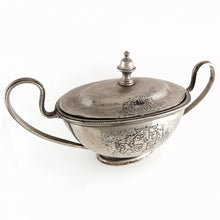Royal Navy- George II Greenwich Hospital Urn, 1740
- Regular price
- £785
- Sale price
- £785
- Regular price
-
- Unit price
- /per
Adding product to your cart
Width: 27cm (10.75in)
Pewter. Twin handled urn complete with knop lid, both engraved with the arms of the Royal Hospital for Seamen at Greenwich within a rococo style cartouche.
In 1742 the parlous state of the pewter used by naval pensioners at Greenwich was reported to the Admiralty, no doubt in the hope it would be replaced. The Lords Commissioners, however, issued a severe rebuke to the Governor - viz. “To Sir John Jennings … Sir, - The Directors of Greenwich Hospital having acquainted my Lords Commissioners of the Admiralty, upon complaint made to them, that the men have been defrauded of part of their just allowance of broth and pease-soup, by the smallness of the pewter dishes, which in their opinion have been artificially beaten flat, and that there are other frauds and abuses attending this affair, to the prejudice of the poor men, I am commanded by their Lordships to desire you to call the officers together in Council, and to let them know that their Lordships think them very blameable for suffering such abuses to be practised, which could not have been done with-out there extreme indolence in not looking into the affairs of the Hospital; that their own establishment in the Hospital is for the care and protection of the poor men, and that it is their duty to look daily into everything, and to remedy every disorder …’
Read More
~section2~
The Royal Hospital for Seamen at Greenwich was established on the instructions of Queen Mary II (1662-1694) after she saw wounded sailors returning from the Battle of La Hogue (1692). It operated as a permanent home for retired sailors of the Royal Navy until 1869. Its famous buildings were designed by Sir Christopher Wren, Nicholas Hawkesmoor and Sir John Vanburgh. The word ‘hospital’ was used in its original sense of a place providing hospitality for those in need of it, and did not refer to medical care, although the buildings included an infirmary.






